Physics Department Colloquium Talk – 04/01/2021 4:00 – 5:00 pm
Dr. Sean P. McBride
“Using Nanoparticle Functionalized Membranes to Reject Negative Species in Solutions”
Abstract:This work highlights how monolayer thick, self-assembled nanoparticle membranes, made from 5 nanometer diameter gold nanoparticles encapsulated with an organic thiol molecule, can be transferred to commercially available filtration membranes to enhance the rejection of charged molecular dyes from water to nearly 100 percent rejection at a concentration of 145 micromolar. Each molecular dye compound dissociates into positively charged sodium ions and a single negatively charged dye molecule. The negative dye molecule concentration in the feed and permeate can be measured using ultraviolet-visible spectroscopy, while the positive ions can be measured via ion specific conductivity measurements. Rejection measurements for the negative dye molecules will be presented for molecular dyes that vary systematically in ionic charge. Molecular dyes are one of the main pollutants in the World’s growing textile industry. The textile, agricultural, and pharmaceutical industry all have negatively charged species in their waste water streams. If these filters can filter out charge molecular dyes similar to those in the textile industry, can they filter out other negative charged items like those found in agricultural and pharmaceutical waste streams? The agricultural and textile industries are some of the largest contributors to fresh water pollution.
Ellie White
“SETI Software Projects at the Allen Telescope Array and the Green Bank Telescope”
Abstract:Are we alone in the universe? This is a question that humans have been asking for hundreds of years, and today, scientists in the related fields of astrobiology and SETI (the Search for Extraterrestrial Intelligence) are working to find answers. The largest SETI project to date is the Breakthrough Listen initiative, which utilizes time on multiple telescopes around the world to search for signs of intelligent life, including the Green Bank Telescope (GBT) in West Virginia. In addition to Breakthrough Listen, another organization which has contributed tremendously to the effort to search for life beyond Earth is SETI Institute, which owns and operates the Allen Telescope Array (ATA) in Hat Creek, CA. In this presentation, I will give a brief overview of Breakthrough Listen and technical aspects of SETI, and I will discuss two projects I’ve been working on over the past year in collaboration with Breakthrough Listen and SETI Institute involving the ATA and the GBT.
Donate to Win – A 45 Quart River Green YETI!
SPS Fundraiser – T-Shirt and Sweatshirt Sale!
T-Shirts $15
Sweatshirts $20
Contact Dr. Sachiko McBride (mcbridesa@marshall.edu) if you have trouble accessing the Physics Department website or experience errors. Questions about the content can be addressed to Dr. Sean McBride (mcbrides@marshall.edu).
